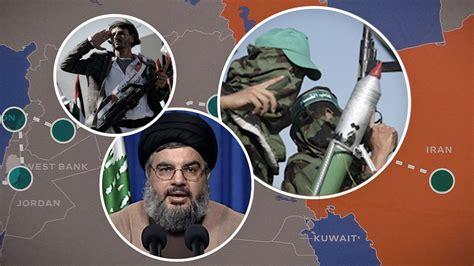
Hezbollah, Hamas, Houthis: How Iran formed ‘Axis of Resistance’ around Israel
Until April 13, Iran had avoided any direct confrontation with Israel and had been fighting a war of attrition with its army of proxies. But with operation True Promise, Iran has crossed a Rubicon.
In a significant escalation of tensions in the Middle East, Iran launched a barrage of over 300 missiles and drones towards Israel, citing a suspected Israeli airstrike on its embassy in Syria on April 1 that claimed the lives of top commanders of the Revolutionary Guards. This aggressive move by Iran comes on the heels of intensified clashes with Israel’s regional allies, sparked by the recent conflict in Gaza.
Despite the severity of the assault, Israeli defence systems, including the renowned Iron Dome, have effectively neutralized the threat, leading to only minor damage within Israel. The collaborative defense efforts, with aid from the US, Britain, France, and Jordan, have played a pivotal role in this successful interception.
Reports confirm the only notable injury was to a 7-year-old child, injured by shrapnel in the incident. On the property front, while an Israeli Air Force base was hit, it remained fully operational post-attack, suggesting the limited impact of the offensive.
Meanwhile, President Joe Biden has issued a caution to Prime Minister Benjamin Netanyahu, stating that the United States will abstain from engaging in any retaliatory strikes on Iran, a measure favored by Netanyahu’s war cabinet in response to a large-scale drone and missile assault on Israeli soil, say officials familiar with the situation.
Apart from urging Israel to show restraint, the US has warned Iran not to escalate the situation further. “Let me be clear: if Iran or its proxies take actions against the United States or further action against Israel, Iran will be held responsible,” deputy US ambassador to the UN Robert Wood said.
While the world anxiously awaits Israel’s response, here is a primer on Iran’s proxies which many strategists have termed as an “Axis of Resistance”.
The term “Axis of Resistance” denotes a coalition primarily opposed to Western influence and Israeli policies in the region.
Here are some notable members of Iran’s “Axis of Resistance”:
Hezbollah
Hezbollah, a Shia militant group based in Lebanon, is the most significant and established member of the Axis of Resistance. Formed in the early 1980s during the Lebanese civil war, Hezbollah’s creation was heavily influenced by the Islamic Revolutionary Guard Corps (IRGC) of Iran, which sought to export its Islamic revolution and counter Israeli and Western influence in Lebanon. Iran has been a key supporter of Hezbollah, providing it with financial support, weapons, and training. This support has enabled Hezbollah to grow into a powerful military and political force in Lebanon, capable of waging extensive military operations against Israel.
Hezbollah’s declared aim is the liberation of Jerusalem and the destruction of the state of Israel. It views itself as a resistance movement against Israeli occupation of Lebanese territory, although Israel withdrew from Lebanon in 2000. The United States, Canada, the European Union, and several other countries have designated Hezbollah as a terrorist organization.
Hamas
Hamas is a Sunni-Islamic fundamentalist organization, which emerged from the Gaza Strip in the late 1980s during the First Intifada (Palestinian uprising) against Israeli occupation. Unlike Hezbollah, Hamas’s formation was not directly orchestrated by Iran, but over time, it has received support from Tehran. This relationship has been somewhat cyclical, with Iran’s support increasing as Hamas’s isolation within the Sunni Arab world grew, particularly after the Syrian civil war, where Hamas’s stance diverged from Iran due to differing views on the Assad regime.
Despite ideological differences—Hamas being predominantly Sunni Islamist and Iran being a Shiite regime—the two found common ground in their opposition to Israel. Iran’s backing of Hamas includes financial aid, military training, and crucially, the supply of rocket technology. This support has enabled Hamas to maintain and enhance its military capabilities within the Gaza Strip.
Hamas’s primary objective is the establishment of an Islamic state in the historical territory of Palestine. The organization has governed the Gaza Strip since it seized control in 2007 and has been involved in numerous conflicts with Israel. The European Union, the United States, and other countries have designated Hamas as a terrorist organization.
Houthis
The Houthis, formally known as Ansar Allah, are a Zaidi Shia-led religious-political movement that emerged from northern Yemen in the 1990s. Their relationship with Iran became more pronounced in the late 2000s as they fought against various Yemeni governments and Saudi-led coalitions. Iran’s support for the Houthis is part of a broader regional strategy to encircle Saudi Arabia and increase pressure on the United States and its allies in the region.
While the Houthis share ideological affinities with Iran, particularly in their opposition to Western influence and Sunni domination in the region, they maintain a level of independence in their operations. The United Nations Security Council and the United States have accused Iran of supplying weapons to the Houthis, which Tehran denies. The Houthis have not been globally designated as a terrorist organization, although they are recognized as such by Saudi Arabia and the United Arab Emirates.
Source » msn.com





